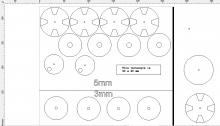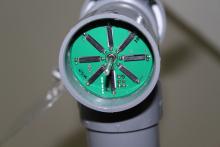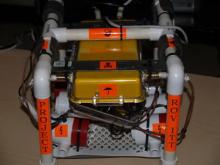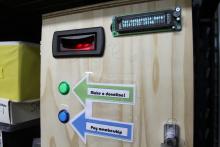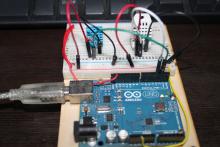published by MRE on Mon, 07/14/2014 - 15:23
I dug out my FreeCAD drawings and made images of the drawing. I am adding those images now, and will link the mechanical file. You can open it in FreeCAD, explore the mechanical design of the spindles, find the parts and make your own modifications.

published by MRE on Mon, 07/14/2014 - 15:18
For flat materials, I have long been using CorelDraw. I began with it back in 1994, and have been loving it ever since. Recently I have been trying to use Inkscape more and more. However, as many of you know, Inkscape has some dimensional issues when working with laser cutters.
Typically, laser cutters use Corel as their go to application for import and cutting. Inkscape files imported in Corel are out of size.
So, in one small escape from totally open source, I have used CorelDraw for my acrylic files.
published by MRE on Sun, 07/13/2014 - 23:33
The PCB above is mounted inside of a 40mm T PVC pipe fitting. It is part of my weather station project, and gave me some interesting challenges to overcome in EagleCAD.
The project called for an array of 8 micro reed switches, arranged in a spoke pattern around a central hole. Further, the whole pcb had to be circular to match the shape of the pipe. it also needed to hold resistors for each switch, a cable connector, and an IC. The hardest part is that the reed switches needed to be recessed INTO the PCB.
published by MRE on Wed, 05/07/2014 - 16:09
It has been a few years since my book Arduino Projects to Save the World came out, and since that time have been asked often what my experience was like.
In addition to this now routine conversation, a friend of mine has recently completed his authoring experience with another publisher. In addition, I am in discussion with yet another friend about coauthoring a new book, and we have been discussing publisher options.
published by MRE on Sun, 03/16/2014 - 07:47
A few years back, I started on this weather station project while at the Tokyo HackerSpace (in our FIRST location). I had grand ideas for the project, but also knew I would likely have a few failures and re-designs. In my assessment, most of the sensors would be easy. Most of the sensors are 'digita' in nature, have no mechanical parts, and I have used on their own several times. The only challenge would be integrating them all in software, and building a suitable case for everything.
published by MRE on Sat, 03/08/2014 - 00:29
The machine has been in opperation a few weeks now and has had no real issues other than a minor code bug that was fixed quickly. It has processed a whole lot of membership payments and donations, with only one bill jam. Unfortunately, since the administrator on site did not have a key yet, they were unable to resolve the issue immediately. But, the member posted their problem on our google group and we were able to work out a solution. That is something that I think ANY cash handling machine has; when a bill or coin jams, there is not much the user can do.
published by MRE on Fri, 03/07/2014 - 22:46
A reader of my book Arduino Projects To Save The World recently asked me about the DHT11 and DHT22 sensors. In particular, how to connect multiple sensors (and how to write the code for it) to an Arduino. I must admit I had never considered it. I have used them plenty of times, but not in parallel. Turns out, Adafruit's DHT library makes it super easy.
Pages






